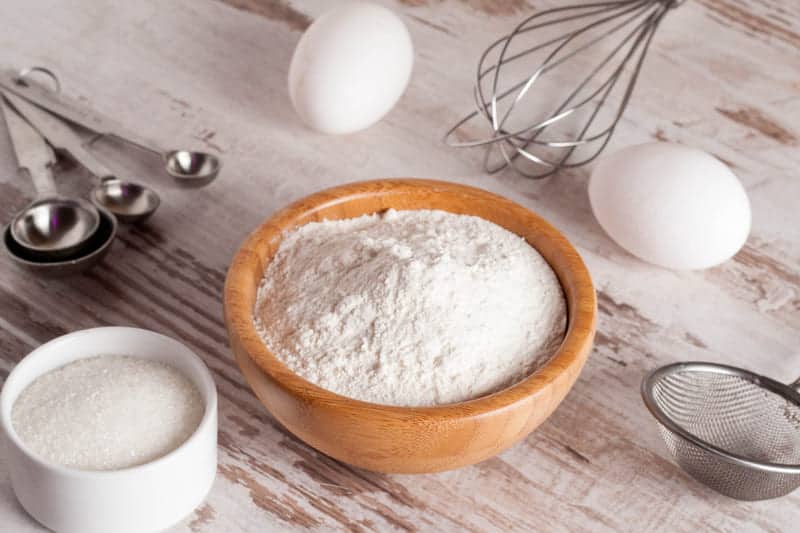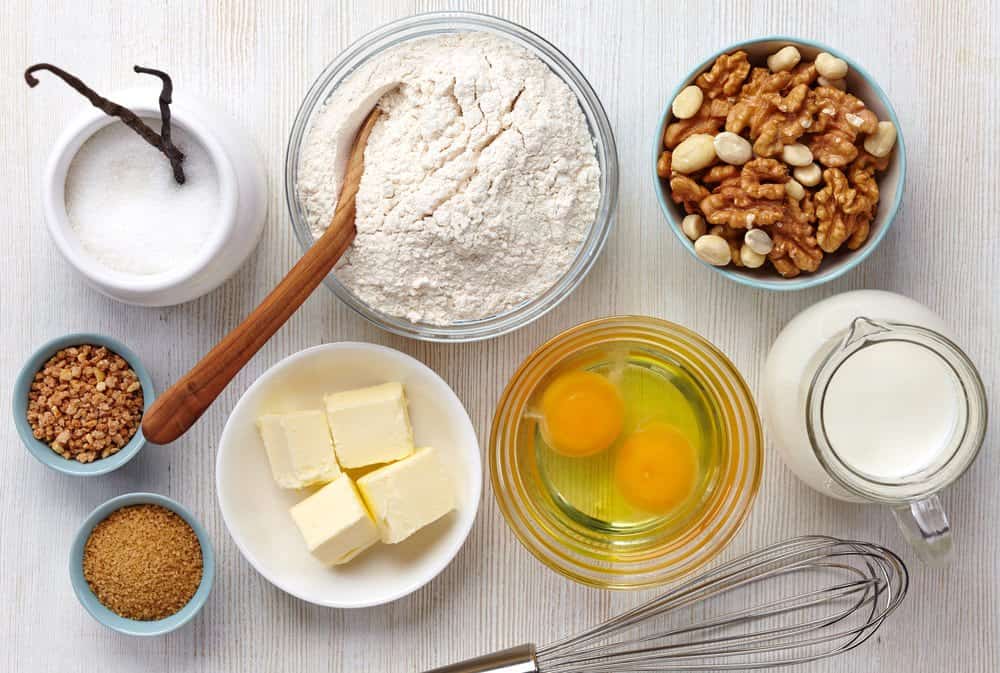Have you ever been confused between cake flour and self-rising flour and do not know which one is right for your recipe?
Well, we all have been there. In this article, we will differentiate between the two in detail so that you can bake the perfect food next time.
Cake flour is finely grounded wheat flour with low protein and gluten content, while self-rising flour is all-purpose flour mixed with salt and baking soda which has a high protein and gluten content.
If you are interested to know more about these flours, keep reading as we discuss in detail the differences between them as well as answer your frequently asked questions!
Cake Flour Vs Self-Rising Flour
We can differentiate between cake flour and self-rising flour on the basis of a few factors. Each of these factors is discussed in detail below!
1. Definition
Cake flour is made of grounded soft wheat and contains no leavening agents. Generally, it consists of just the endosperm of the wheat.
If you go to a supermarket, you will find bleached cake flour there. However, what does it mean? Well, it means that the cake flour uses different bleaching agents to speed up the whole process. This process makes the flour extra white and even changes its taste, appearance, and smell.
It is why when you make a cake using cake flour, it remains moist and soft. Additionally, you will find that the cake has a nice crumb and does not get over brown in color.
On the other hand, self-rising flour is basically plain wheat flour with leavening agents like salt and baking powder. You can find unbleached and bleached self-rising flour in stores.
However, it is equally difficult to find unbleached cake flour. So, if you are someone who avoids bleached flour for health reasons, you can try unbleached self-rising flour in place of cake flour.
2. Protein Content
The main reason cake flour has soft wheat is because it has lower protein content as compared to self-rising flour. The protein content ultimately decides the texture of the cake. Therefore, it is important you know about it.
Generally, a typical cake flour contains about 8% protein content whereas self-rising flour has a slightly higher protein content i.e. 8-10.5%. So, any cake made from self-rising flour will be hard to chew and very thick.
3. Gluten Content
Naturally, flour with higher protein content will have a higher gluten content as well as protein creates gluten in the batter.
Therefore, cake flour has around 7.5-9% gluten content, while self-rising flour has around 9.5% or higher gluten content.
4. Ingredients
If you read the back of your cake flour pack, you will see two main ingredients: milled soft wheat and cornstarch or arrowroot powder. There are no leavening agents in the ingredients.
As the name suggests, the self-rising flour contains all-purpose flour and leavening agents like baking powder and salt. These leavening agents expand the batter by releasing gasses into it. This makes the batter porous and lighter than other batters. Moreover, they save time in the kitchen.
5. Use
There is no guess that cake flour is apt for preparing cakes and cupcakes.
However, did you know you can make so much from them such as brownies, layer cakes, scones, pastries, and desserts that are soft and fluffy?
The best use of self-raising flour, on the other hand, is by preparing bread, peanut butter bars, pizza dough, cookies, and biscuits.
Not only this, you can try to make savory dishes like beer-battered cod, pinwheels, and whatnot!
6. Texture
Cake flour is finely grounded, therefore has a very fine texture. Whereas when you touch self-rising flour, you will find it a bit rough as it contains salt and baking powder also.
Cake Flour Vs Self-Rising Flour: Comparison Chart
To summarize the difference so far, take a look at the table below!
| Characteristics | Cake Flour | Self-Rising Flour |
| Definition | Grounded and bleached soft wheat flour with no leavening agent | Bleached or unbleached plain flour with a leavening agent |
| Protein Content | Low at about 7-9% | Slightly higher at about 8-10.5% |
| Gluten Content | Lower gluten content at about 7.5-9% | Higher gluten content at about 9.5% |
| Ingredients | All-purpose flour, cornstarch | All-purpose flour, salt, baking powder |
| Use | Baked goods like cakes and cupcakes | Biscuits, bread, pizza dough |
| Texture | Fine | Not fine |
Can You Use Self-Rising Flour Instead Of Cake Flour?
We do not advise substituting cake flour with self-rising flour as it has baking powder and salt. On the other hand, cake flour is a non-rising flour with no baking powder added to it.
The bleached cake flour binds fats in the recipe better and stabilizes the gas molecules present in the batter due to leavening agents. It is vital in a cake recipe that requires a high amount of sugar. It makes the cake more tender and fluffy.
What Can I Use If I Don’t Have Cake Flour?
If you are in a hurry and forgot to get the cake flour from the supermarket near you, no worries. You can always prepare a cake with ingredients generally present at your home. How? Read on to know how to make cake flour at home if you do not have any:
- For every cup of cake flour, take a cup of all-purpose flour minus two tablespoons of all-purpose flour. Add it to a large mixing bowl.
- Add two tablespoons of arrowroot powder or cornstarch to the bowl.
- Sift it thoroughly to lighten and aerate the mix. And, your cake flour is ready to be used!
If you do not have the time to make homemade cake flour, you can use ready-made substitutes like bread flour.
However, bread flour has high protein and gluten levels, in comparison to cake flour. Therefore, the cake will not come out as you desired. To avoid this, add yeast to the mix before using it.
Does Cake Flour Make A Difference?
When you understand the finer points of cooking and baking, you realize cake flour really does make a difference in cooking.
Cake flour is prepared in a way that makes the cake fluffy, airy, and less chewy. Therefore, it is best to use cake flour to make baking goods if the recipe calls for it.
What Is Cake Flour Vs All Purpose?
We can differentiate between cake flour and all-purpose flour on two grounds:
Protein Content
Cake flour has low protein content (about 8%), which is why it is suitable for baking cakes.
Protein is directly related to gluten formation, therefore, less protein content in the mix means less gluten formation. It is the reason why your cake is soft, tender, and fluffy.
On the other hand, all-purpose flour has higher protein content (about 10-12%), so there is higher gluten formation.
This makes the cake hard, tough, and tight. It is difficult to chew as compared to a cake made of cake flour.
Wheat Type
Cake flour is made from soft wheat. It is light-golden-colored wheat that has more starch and less gluten to it. It makes the flour lighter and great for cakes, pastries, biscuits, and other confectionery products.
While all-purpose flour either has hard wheat or a mix of hard and soft wheat. Since hard wheat has higher protein content, all-purpose flour has more gluten making it an unwise choice for cakes and baking goods.
How Do You Turn Self-Rising Flour Into Cake Flour?
In case, you have an urgency and self-rising flour is available at your home, you can bake cakes and cupcakes using it.
To turn a self-rising cake into cake flour, just make sure you do not add additional salt or baking powder to the recipe as it will double the amount. In addition to that, remember the cake made from self-rising flour will turn out denser and chewier than any normal cake.





1 comment
thank you, yr article is insightful